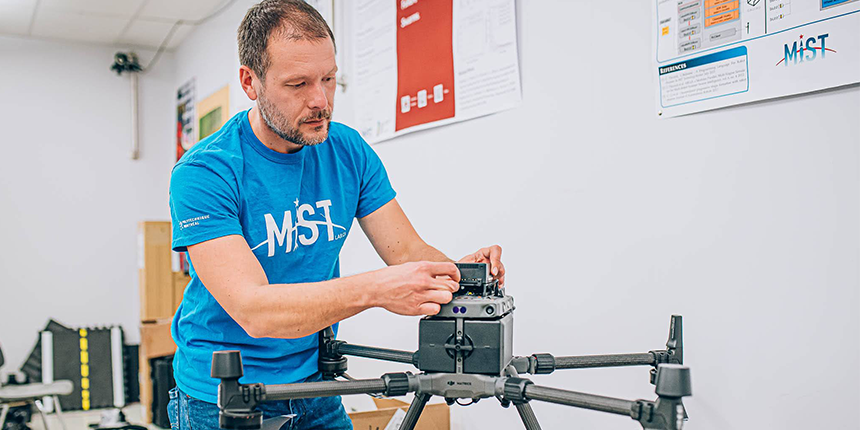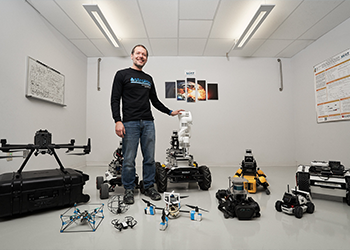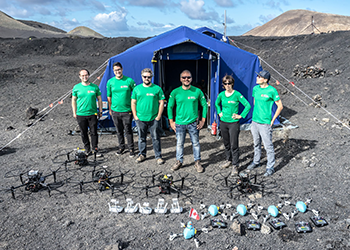

When questioning the educational path he should follow, Giovanni Beltrame was wise not to listen to friends and family when they suggested he pursue business studies. Content in his chosen field as a researcher specializing in swarm robotics and embedded systems, Beltrame is passionate about inventions that advance humanity as a whole.
His dream began at the age of six. While most other children happily played with Legos, he was already building programs on a personal computer that had only 48 KB of memory. Fueled by a passion for math, the young Italian enrolled at the Politecnico, Milan’s prestigious engineering university. Not content with one degree, he followed that Laurea with a dual M.Sc. degree from the University of Illinois Chicago, not limiting himself to one Master’s program but opting for two, one in electrical engineering and the other in embedded systems. After a brief stint as a consultant, he embarked on a PhD program in computer engineering, combining these embedded systems and robotics.
This appetite for knowledge aptly describes Beltrame’s career. Keenly interested in the discovery of the universe, in 2007 he was chosen as one of 900 applicants among 8,000 to become astronauts. While the opportunity to fly among the stars never materialized, he continued to be involved as a microelectronics engineer at the European Space Agency. During his four years with the Agency, he worked on the effects of space radiation on electronic systems, as well as on the design of embedded multiprocessor systems.

Heading towards other planets
In 2010, Beltrame joined the Polytechnique Montréal, and another research avenue opened up. A chance encounter with a robotics specialist brought him back to one of his doctoral theses, and he found himself involved in multi-robot systems that were capable of better understanding far-away environments, such as those of the Moon and Mars. “I’m interested in producing technologies that will be used to explore these regions, especially craters where permanent settlements could be established,” he explains.
With some 20 Master’s and PhD students that he supervises, Beltrame is currently working at the MIST Laboratory on robots capable of not only perceiving their environment but most importantly of working together. Inspired by nature and the communication systems used by insects and fish, he discovered that groups of robots have a type of shared memory. As this professor who teaches a course on swarm intelligence with a focus on swarm robotics in Canada explains, this marks a major breakthrough. It is now possible to combine various robot specializations to better map lunar and martian craters and analyze in detail these environments as yet unknown. This process resembles the work being done this year by Beltrame, co-founder and director of the Astrolith at the Polytechnique.

This transdisciplinary research unit in space resources and infrastructure engineering brings together 23 Polytechnique professors from seven departments, drawing on the specialities of each one of them. Space mining specialists interact with architects, geotechnical and sensor development researchers, resulting in a unique research force to perfect technologies that may one day be used on the Moon or other planets.
Applications on Earth
The drones, wheeled robots and crawler robots designed by Beltrame and his students and financed by the Canadian Space Agency and NSERC also have applications on Earth. The mining industry is now able to apply their perceptual systems to better utilize critical minerals present in waste, thereby minimizing the use of resources. Swarm robots could also be used in fields to detect weeds and plant diseases, reducing the need to use herbicides and pesticides.

Proud of fostering his students’ interest in these new technologies, Beltrame also hopes to inspire younger students. “Our role as engineers is to convince as many people as possible to develop their creativity and invent new systems that are useful for humanity,” he says. To this end, he gives presentations in elementary schools and hosts scientific cafés. “Children love robots, so it’s a great way to reach them.”
Through it all, the professor continues to have fun with this technology, gladly sharing photos taken of missions during which researchers test their creations in environments resembling the Moon or at the bottom of dark caves. It is one way of ensuring that the systems that are developed can be used on another planet in the not-too-distant future.
Engineers build more than just bridges. Building Tomorrows is a series that highlights the important contributions of engineers and the many ways they help to make our world a better place.
Engineers build more than just bridges. Building Tomorrows is a series that highlights the important contributions of engineers and the many ways they help to make our world a better place.


